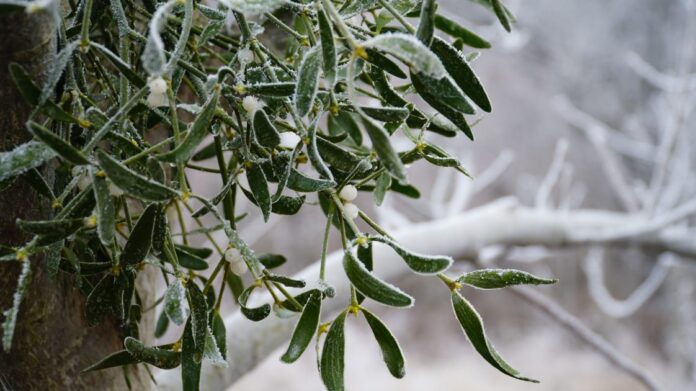AUBURN UNIVERSITY, Ala. — At Christmastime, many people may find mistletoe to be a natural ornament that signifies the holiday season. However, forestry experts with the Alabama Cooperative Extension System may not botanically consider it romantic, merry or bright. This is because mistletoe, in its most natural form, is parasitic — making it appear a little less jolly outside the home.
History and folklore

Mistletoe on a hardwood tree branch
Most people recognize mistletoe from the tradition of sharing a kiss while standing under its sprigs. The lesser-known fact about this tradition is that it started approximately 2,000 years ago.
Historians believe that mistletoe’s romantic origins likely began with the Celtic druids of the first century. These tribes of Europeans shared many religions and culture. They made homesteads in areas known today as Ireland, Great Britain, Spain and France.
The first evidence of this tribe is documented by the Roman Empire, ruler over most of southern Europe during the seventh and eighth centuries. The Romans referred to the Celts as Galli, translating to barbarians. Mistletoe locally blossomed in the winter, making the Celts associate the plant with a symbol of life. This later influenced the druids to feed the plant to their people in hopes to restore fertility.
A popular belief of mistletoe folklore derives from mythology. The Norse god, Odin, had a son, Baldur, who was destined for death. Odin’s wife, Frigg, the goddess of love, secured a promise of life with all the natural world’s plants and animals in hopes that they would not harm Baldur. However, Frigg did not make a pact with mistletoe, leaving it as a threat. The infamous and scheming god, Loki, made an arrow using the plant, which was later used to kill Baldur, who was thought to be invincible.
The myth says later that Baldur was resurrected, which influenced Frigg to use the plant as a symbol of love. She then vowed to kiss all those who passed under it, leading to today’s tradition.
Biology
Although there are at least 30 species of mistletoe in the Unites States, only one is native to Alabama. Phoradendron leucarpumis, commonly referred to as American mistletoe, is typically in holiday décor.
This Alabama-native species is a small evergreen shrub that grows on hardwood tree branches. Its leathery, opposite leaves and white berries give this plant its identity. The plant spreads via birds when they eat the berries and deposit the seed to a new location. A sticky outer layer helps the berry stick and eventually germinate into the host plant.
Nancy Loewenstein, an Alabama Extension forestry, wildlife and natural resources specialist, said mistletoe, away from a holiday party, is hemiparasitic, or partially parasitic.
“Mistletoe uses water and nutrients from its host tree but produces its own sugars through photosynthesis,” Loewenstein said. “A few mistletoe plants on healthy trees typically have little significant impact. But large numbers can reduce tree vigor. This is especially the case during drought conditions, when mistletoe plants use water that the host tree can little afford to lose.”
If choosing to decorate with real mistletoe, be sure to keep it out of the mouths of children and pets because of its toxicity. Although moderately poisonous, when eaten in large quantities, mistletoe can cause symptoms of intestinal irritation, diarrhea, vomiting, difficulty breathing, slow pulse and lower blood pressure.
Friend or foe?
In the sense of holiday cheer, make sure that mistletoe remains solely as a decoration and tradition this year. Keep this plant away from the mouths of loved ones, and teach others about mistletoe at your next Christmas party.
If you find that your trees are overrun with mistletoe, information on controlling this parasitic plant is available in the Alabama Extension publication, “Controlling Mistletoe in Trees” at www.aces.edu.





















